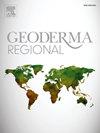矿物学对土壤钾储量的控制:巴西东南部(巴西里约热内卢州)的一个案例研究
IF 3.3
2区 农林科学
Q2 SOIL SCIENCE
引用次数: 0
摘要
评估土壤钾储量对于帮助制定减少热带国家对钾肥依赖的战略至关重要。对巴西东南部(里约热内卢de Janeiro State)的6个土壤样本进行了调查,以更好地了解矿物学对其钾储量的控制。通过x射线衍射对矿物组合进行了表征,用Rietveld精化法确定了粗粒组分中的矿物含量,用NEWMOD法描述和量化了粘土组分中的间层。测定样品中的总K (Kt)和非交换K (Kne)。中等风化的Cambisol样品中Kt和Kne含量最高,粗组分中原生云母含量高,粘土组分中富含伊利石层间相。富高岭石的高风化土(lixisol和a Histosol),富耐候原生矿物(k -长石、斜长石和角闪石)的弱风化土(Phaeozem和Chernosol),层间粘土(2:1)的Kt和Kne含量为低至中等。Kt和Kne含量与伊利石层序呈显著正相关,主要分布在高岭石-伊利石间层序。多元统计方法可以将Kt、Kne、原生云母和伊利石层作为组合变量,用于区分Cambisol样品和其他样品,这些样品具有较低的K储集层。白云母和Kne之间缺乏相关性可能与标准方法(硼酸钠四苯酯)对Kne含量的低估有关,这可能是由于其无法有效地从粗颗粒中提取Kne。这些发现强调了富含伊利石的层间粘土是研究的热带土壤中钾储量的主要矿物学控制因素。本文章由计算机程序翻译,如有差异,请以英文原文为准。
Mineralogical controls over soil K reserves: A case study in Southeastern Brazil (Rio de Janeiro State)
Assessing soil potassium (K) reserves is essential to help developing strategies focused on reducing the dependence of tropical countries for K-fertilizers. Samples from six soils located at Southeastern Brazil (Rio de Janeiro State), were investigated to better understand the mineralogical control over their K reserves. Mineral assemblage was characterized through X-ray diffraction, using Rietveld Refinement to determine minerals contents in the coarse fractions and NEWMOD to describe and quantify interstratifications in clay fraction. Total (Kt) and non-exchangeable K (Kne) were determined in the samples. The highest Kt and Kne contents were observed in moderately-weathered Cambisol samples, with high primary mica contents in coarse fractions, as well as illite-rich interstratified phases in the clay fraction. Highly-weathered soils (Lixisols and a Histosol) rich in kaolinite, poorly-weathered soils (Phaeozem and Chernosol) rich in weatherable primary minerals (K-feldspars, plagioclases and amphiboles), and interstratified clays 2:1 clays presented low-to-moderate Kt and Kne contents. There was a positive and significant correlation of Kt and Kne contents with illite layers, mainly allocated at kaolinite-illite interstratifications. Multivariate statistical approach enabled assigning Kt, Kne, primary micas and illite layers as combined variables accounting for differentiating Cambisol samples from other samples, which presented lower K reservoirs. The absence of correlations between muscovite and Kne may be related to an underestimation of Kne content by standard method (Na-tetraphenyl borate), likely due to its incapacity of extract Kne efficiently from coarse particles. These findings emphasize illite-rich interstratified clays as major mineralogical controls over K reserves in the investigated tropical soils.
求助全文
通过发布文献求助,成功后即可免费获取论文全文。
去求助
来源期刊

Geoderma Regional
Agricultural and Biological Sciences-Soil Science
CiteScore
6.10
自引率
7.30%
发文量
122
审稿时长
76 days
期刊介绍:
Global issues require studies and solutions on national and regional levels. Geoderma Regional focuses on studies that increase understanding and advance our scientific knowledge of soils in all regions of the world. The journal embraces every aspect of soil science and welcomes reviews of regional progress.
 求助内容:
求助内容: 应助结果提醒方式:
应助结果提醒方式:


